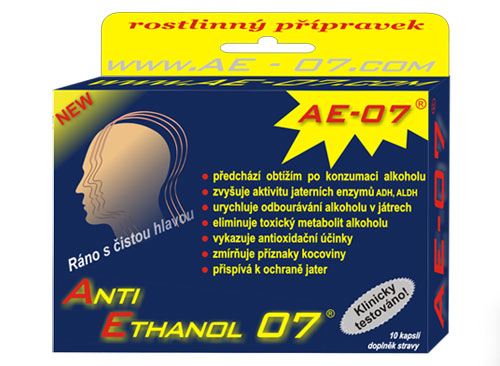AE-07® :: resorption of alcohol
Resorption of alcohol in the organism is based on simple diffusion. About 20 % of alcohol is absorbed from the stomach, while 80 % of alcohol is absorbed from the duodenum and the upper small intestine. About 90 to 95 % of alcohol is converted in the organism via oxidation in the liver, about 10 % is eliminated in an unchanged form. Through breathing, about 4-7 % is eliminated, while 1 to 3 % is discharged with urine. Proper degradation of alcohol runs in the liver, being mediated by two enzymes - alcohol dehydrogenase (ADH) and aldehyde dehydrogenase (ALDH). Alcohol dehydrogenase ensures conversion of ethanol to acetaldehyde, which is further metabolized by the enzyme aldehyde dehydrogenase to acetic acid and acetyl coenzyme A.
Adverse symptoms appearing after alcohol include primarily headaches, dizziness, nausea, reduced capacity of concentration and higher fatigue. These symptoms grade up until next morning, which is true even after only low and medium doses of alcohol. Cognitive and mental functions of the central nervous system are adversely affected by these symptoms and work performance is reduced. Human organism is able to degrade 8.5 g of alcohol per hour, on the average. Rate of alcohol degradation depends on many factors as sex, body mass and frequency of alcohol use. These side reactions are caused primarily by accumulation of acetaldehyde which is produced as a toxic product on alcohol degradation in the liver.

Acetaldehyde originates as a toxic product of alcohol degradation in the liver and is further metabolized to acetic acid and acetyl coenzyme A. Acetyl coenzyme A is then converted to carbon dioxide and water via Krebs cycle. Acetaldehyde affects adversely all organ systems, however most of all the nervous system and the liver. It pushes out calcium from cellular membranes and generally impairs their physiological function. It is also a cause of the oxidation stress and leads to an enhanced production of free radicals, the adverse influence of which on our organism is generally known. Acetaldehyde exhibits a considerable affinity to an important anti-oxidation factor, so called reduced glutathion (GSH) that occurs naturally in the organism.
Glutathion is a tripeptide composed of three amino acids, i.e. glutamic acid, cysteine and glycine. Being a strong anti-oxidative factor, it inhibits the production of free radicals originating within metabolic processes running in the organism. Through its bond to reduced glutathion, acetaldehyde interferes with the balance between its reduced and oxidized form, which subsequently results in an increased accumulation of free radicals. Through this mode of action, it causes an enhanced accumulation of fat in parenchymal cells of the liver and consequently even fibrosis and cirrhosis of the liver. Acetaldehyde also interferes with the metabolism of biogenic amines. In this context, produced are substances named tetraisoquinolines that act as false neurotransmitters. At the same time, acetaldehyde stimulates an enhanced synthesis of collagen, contributing thus to the development of hepatic . Simultaneously, it impairs the bond between the so called intrinsic factor and vitamin B12. Vitamin B12 is not able of an independent penetration through biological membranes due to its relatively large molecule. Therefore, for resorption, it must be bound to a highly specific factor, i.e. glycoprotein, which is produced by parietal cells of the gastric mucous membrane. The complex created like this is then shifted into the small intestine where it is resorbed. Based on acetaldehyde activity, an interference into this physiological process may lead in its turn to the development of pernicious megaloblastic anemia. Out of symptoms occurring immediately after alcohol consumption, primarily headache, reduced ability of concentration, vertigo and higher fatigue are caused by acetaldehyde.
Glutathion is a tripeptide composed of three amino acids, i.e. glutamic acid, cysteine and glycine. Being a strong anti-oxidative factor, it inhibits the production of free radicals originating within metabolic processes running in the organism. Through its bond to reduced glutathion, acetaldehyde interferes with the balance between its reduced and oxidized form, which subsequently results in an increased accumulation of free radicals. Through this mode of action, it causes an enhanced accumulation of fat in parenchymal cells of the liver and consequently even fibrosis and cirrhosis of the liver. Acetaldehyde also interferes with the metabolism of biogenic amines. In this context, produced are substances named tetraisoquinolines that act as false neurotransmitters. At the same time, acetaldehyde stimulates an enhanced synthesis of collagen, contributing thus to the development of hepatic . Simultaneously, it impairs the bond between the so called intrinsic factor and vitamin B12. Vitamin B12 is not able of an independent penetration through biological membranes due to its relatively large molecule. Therefore, for resorption, it must be bound to a highly specific factor, i.e. glycoprotein, which is produced by parietal cells of the gastric mucous membrane. The complex created like this is then shifted into the small intestine where it is resorbed. Based on acetaldehyde activity, an interference into this physiological process may lead in its turn to the development of pernicious megaloblastic anemia. Out of symptoms occurring immediately after alcohol consumption, primarily headache, reduced ability of concentration, vertigo and higher fatigue are caused by acetaldehyde.